Love him or hate him, it is undeniable that Elon Musk has disrupted every industry that he touched, from cars to rockets. Known for his unique approach to problem-solving that embodies years of experience across multiple industries, we take a look at Musk’s five-step approach to system design and how we might apply them to humanity’s greatest challenges.
© 2025 J.K. Lund
Substack is the home for great culture




